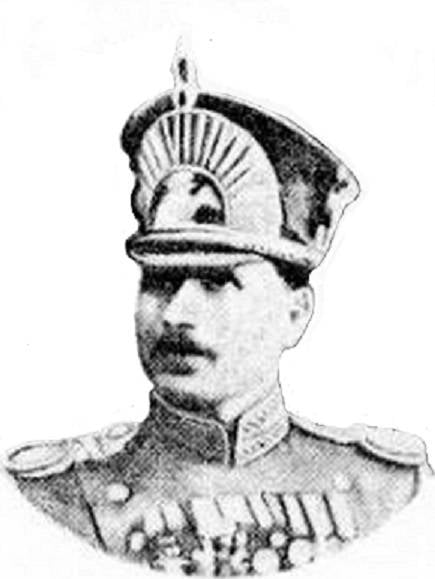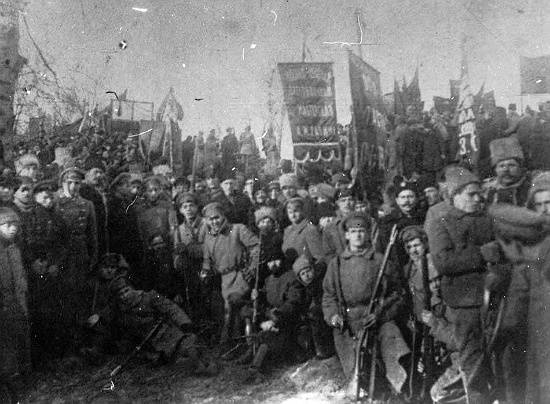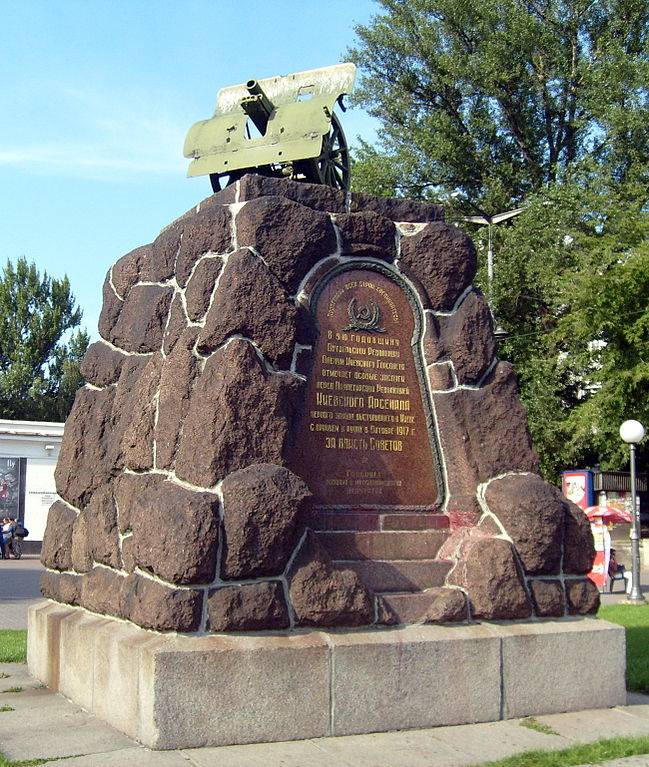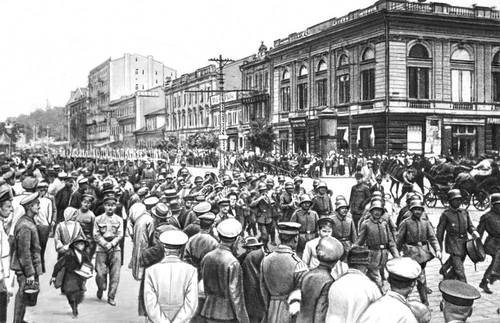How the red took Kiev
"Free Cossacks" from the same decayed front-line units basically simply ran up with the first shots or even without them. The common people did not accept the idea of a “separatist” Ukraine. As a result, Muravyov’s red “army” of about 8 thous. Bayonets easily advanced to Kiev and took it.
The beginning of hostilities
The Red Army was in the making. The Southern Revolutionary Front for Combating Counter-Revolution V. A. Antonov-Ovseenko initially had 6 – 7 thousand bayonets and sabers with 30 – 40 guns and several dozen machine guns. At the same time, the composition of the core of this army was constantly changing due to various reasons. So, some parts were completely inefficient, and when they captured cities, they immediately indulged in drunkenness and robbery, and they had to be disarmed.
As usual, during the turmoil, criminals, people with mental disabilities (sadists in particular), etc., were promoted from the social bottom to the forefront. They used their new position to rob, torture, and kill "bourgeois", "officer". Old men, women and children were also hit. There were flashes of the “red terror”, often unreasonable with nothing but the personal qualities of commanders, commissioners and their subordinates. Among the "commissars" were real monsters, pathological maniacs, literally drowned whole settlements in the blood. It should be remembered that on the other side of the front the angels also did not fight - white, Cossack, green (gangster), nationalist terror was no better. Also, people were slaughtered on the national and religious grounds of (Russian) Basmachis in Turkestan, Crimean nationalists in the Crimea, and highlanders in the Caucasus. The most brutal terror was on the part of the invaders - Romanian, Austro-German, Anglo-American, Japanese, etc. It was the most terrible and bloody war - civil.
The main core of the Red Army consisted of a wide variety of units: the base was the units of the old army, isolated from the front and rear backup regiments, sailors' detachments and local Red Guard detachments. They differed sharply in quality: some parts were an example and a deterrent for others in various columns and detachments; others had to be disarmed and sent home. At the same time, the main core was rather rapidly built up when the forces of the local detachments of the Red Guard and local pro-Soviet garrisons from the old army advanced. So, Kharkov gave 500 Red Guards, Yekaterinoslav - 3000 fighters, Nikolaev - more 800 Red Guards and Bolshevik-minded 45 th infantry reserve regiment with a strength of about 3 thousand bayonets. The Donets Basin also significantly strengthened the red southern front.
Thus, the decisive, offensive nature of the strategy of the red command promised success. As the “echelon war” —the advance of troops and columns along strategic highways — the forces of the Red Army grew rapidly. At the same time, initially in numbers, the counterrevolutionary forces of Kaledin and the Central Rada were in no way inferior to the Soviet troops and even had some superiority. In particular, in Ukraine there were hundreds of thousands of soldiers, large reserves weapons and equipment, however, the Ukrainian government due to poor managerial qualities and lack of support from the people (respectively, the army), in December 1917 - January 1918. could expose scattered parts totaling about 15 thousand people. At the same time only a few thousand fighters were relatively effective.
Red Stavka initially directed its main efforts against the Don government of General A. M. Kaledin. The plan of the Soviet command was as follows: 1) to interrupt the railway communication between Ukraine and Don; 2) open a message to the Donbas bypassing the North-Donetsk Railway, acting through Lozovaya-Slavyansk; 3) establish a connection between Kharkov and Voronezh through Kupyansk - Liski; 4) to establish contact with the North Caucasus, where the Bolshevik-minded 39-I infantry division was moving from the Caucasian front.
Thus, the original plan of the Soviet command did not suggest a large-scale war against the UNR, a campaign against Kiev and the liquidation of the Central Rada. The main threat was seen on the Don. Antonov-Ovseenko handed over command of the troops stationed in Ukraine to his chief of staff, Muravyov, and himself led the fight against the White-Guard troops of Don.
17 (30) of December Egorov's detachment (1360 people with 3 guns and 1 armored train) occupied Lozovaya station, and then the city of Pavlograd. The Ukrainian Haidamaks who defended Lozovaya and Pavlograd (as following the example of insurgent detachments in the 18th century, some parts of the UPR called themselves) fled without a fight or surrendered. Thus began the advance of the Red troops and the Sovietization of Ukraine, relying on local revolutionaries. Meanwhile, on the Don Front, Sivers’s column slowly marched from Kharkov to the Donets Basin, disarming small Ukrainian garrisons along the way.
By 7 January 1918, the Soviet troops, shielding themselves from the forces of the Rada through the railway stations Vorozhba - Lyubotin - Pavlograd - Sinelnikovo, occupied the main forces of the Don basin. As N. Ye. Kakurin noted in his work “How the Revolution Fought”: the closeness of the Soviet troops “caused a number of local explosions from within that overthrew the power of the Central Council in a number of large industrial and port centers of Ukraine. These explosions, in addition to the spatial expansion of the revolution, further simplified the tasks of the Soviet strategy in the final act of its struggle against the Ukrainian Rada. ”
December 26 1917 of the year (January 8 of the year 1918) with the support of the Red Guards under the command of P.V. Egorov Soviet power was established in Yekaterinoslav. The number of Red losses speaks well of the weakness of the “Ukrainian army”: only 10 people were killed and 20 injured. December 26-27 (January 8-9) Antonov-Ovseenko troops captured the largest industrial centers of Lugansk and Mariupol. On the night of December 28 (January 10), local Red Guards disarmed the 2 th regiment of the UNR in Kharkov, which until then had been in the rear of the red front, taking the position of "neutrality". The disarmed soldiers of the UPR were dismissed to their homes, and the 300 soldiers who wished to join the Soviet troops were enlisted into the staff of the Soviet army as an independent unit — the Red Cossack regiment (Red Cossacks).
By January 2 (15), Aleksandrovsk was busy, which made it possible to establish contact with the Crimea, and the Bolshevik forces settled down for further actions in the direction of Mariupol - Taganrog - Rostov. January 12, the uprising of workers was occupied from within Mariupol. On January 5 (18), after several days of stubborn battle with supporters, workers are pleased with the support of the Black Sea sailors fleet established Soviet power in Odessa. On the same days in Crimea, the red sailors of the Black Sea Fleet crushed local counter-revolutionaries and Crimean Tatar nationalists in a few days.
While the CR was defeated in the south and east of Little Russia, its attention and part of the forces were directed to the west. Rada continued to fight with the Sovietized units of the old army on the South-Western Front, whose revolutionary bodies sought to expand their sphere of influence east of the front line and move closer to Kiev. However, here the initiative was in the hands of the CR. Taking advantage of the complete disintegration of the troops of the front, the Central Committee successfully fought against the military revolutionary committees. So, he was arrested by the Revolutionary Committee of the Special Army. 2-th Guards Corps made a weak attempt to take Zhmerinka and Vinnitsa, but it failed.
Attempts by the Red Headquarters to concentrate troops from the front in Bryansk, Novozybkov and Kolinkovichi also did not lead to success. Most regiments arrived abandoned the conduct of hostilities. It was necessary to form new revolutionary units. It was possible to put 3 thousand soldiers and 400 sailors with 12 guns, which operated from Gomel in the direction of Bakhmach. Thus, from the side of the old front, to take Kiev, and there was no possibility to suppress the government of the Ukrainian nationalists. The maximum that could be counted on is only a diversion of a part of the forces of the CR to the west.

M. A. Muravyov in the form of a captain of the Russian Imperial Army, 1916 year
Sturm of Kiev
As a result, in the conditions of a lull on the Don front and an increase in revolutionary activity in Little Russia (Ukraine), the Soviet command decided to launch operations on the Don and in Ukraine almost simultaneously. The need for an attack on Kiev was also caused by a foreign policy factor — the Ukrainian delegation was negotiating a separate peace with the Germans in Brest. The military prerequisite for this decision was the weakness and disintegration of the troops of the Central Committee.
4 (17) January 1918, the Soviet government of Ukraine officially declared war on the Central Rada. 5 (18) January Antonov-Ovseenko issued a directive on the general offensive of the Soviet troops against the forces of the Central Committee. The Red Headquarters was to send all combat-ready units from the Romanian and South-Western fronts to Kiev and develop the offensive from Gomel to Bakhmach and Kursk. The detachment of A. Znamensky at Vorozhba (Moscow Special Purpose Detachment) was reinforced with 1000 bayonets and artillery. The main blow, it was decided to apply from Kharkov to Poltava in the further movement to Kiev, together with the Bolshevized units of the former old Russian army, which threatened Kiev from all sides. The overall management of the operation was assigned to the chief of staff of the Southern Group of Forces Muraviev. For this purpose, an armored train and an 500 man of pure Cossacks and Red Guards were transferred to him. Egorov, with his squadron in 1200, a man and an armored train at the same time as Muravyov’s convoy had to attack from Lozova. Both columns followed in echelons.
Rada was unable to organize the resistance of the advancing Soviet army. Ukrainian leaders continued the debate on the background of the outbreak of war. Vinnichenko proposed to continue negotiations with SNK and withdraw the troops. Petliura suggested organizing an immediate offensive of the units of the UPR against Kharkov and creating small mobile units from the remaining composition of the old decomposed divisions for using them along the railways (that is, repeating the Red tactics). Petliura was dismissed from the post of military secretary and removed from the General Secretariat. Nikolai Porsh, who had no military experience, was appointed Secretary General for Military Affairs. The General Secretariat adopted a resolution on the creation of an army of the UPR on the principles of voluntariness. 3 (16) January 1918 of the year issued a temporary “Law on the formation of the Ukrainian People’s Army”, according to which the Ukrainianized regiments of the regular army were to be dissolved, replacing them with the people's militia. 4 (17) January Porsche ordered the complete demobilization of the army. And to form a new army Rada could not. Volunteers to protect it turned out to be extremely small. 9 (22) January Rada proclaimed the complete separation of Ukraine from Russia, and intensified separate negotiations with the Germans.
In Kiev itself, the Reds had supporters who intensified with the advance of the Soviet troops in Little Russia. On the night of 4 on 5 in January, a large-scale military operation was carried out in Kiev — disarming the Red Army workers of the Kiev factories by the Central Committee forces, during which they seized a large number of weapons, arrested more 200 activists, and seized the printing house of the Bolshevik newspaper Proletarian Thought. 16 (29) January, an uprising began at the Arsenal plant. It was joined by workers from other enterprises of the city, revolutionary soldiers. To suppress the uprising, the Rade had to withdraw the troops under the command of S. Petliura and Colonel V. Petrov from the front. January 22 (February 4) “Asenal” took by storm, the uprising was drowned in blood. After the suppression of the uprising, more than 300 participants were shot. In total, more than 1500 people died during the uprising.

A group of armed workers. Kiev, January 1918 of the year
The offensive of the columns of Znamensky, Muravyov and Egorov developed successfully. City Glukhov took easily. Not encountering any resistance on his way, Muravyov approached Poltava and 6 (19) of January took her, having lost the whole 1 man killed. The next day, Yegorov’s column arrived there. Not encountering any resistance, Muraviev’s troops continued their movement, disarming the local garrisons who did not want to fight. January 24 Red occupied Romodan and Kremenchug, then Lubny and the field of a small battle of Art. Comb.
From Gomel to Bakhmach and further to Kiev, the 1 of the Minsk Revolutionary Army under the command of Berzin and Vatsetis advanced, composed of units of the old Russian army, taken from different fronts by order of the Stavka. The 28 army fought for the Kruty station and on January 30 the Reds took the station. Thus, the road to Kiev was open. However, further movement was prevented by the damage of the railway and bridges, which the retreating Haidamaks produced.
Muravyev's troops met with some resistance on the Trubezh River. Here the Reds came into contact with parts of the Czechoslovak Corps, which declared its neutrality. For the defense of its capital, Kiev, the CR formally had 20 thousand people, but there were few reliable troops 1200 people of the “strong cossack” - irregular formations of petty-bourgeois and intellectual elements and two Haidamak regiments of “red Haidamaks” from front-line soldiers, hostile to them the Bolsheviks, and the “black haidamaks”, consisting mainly of the junkers of the Ukrainian military schools. In Kiev, there were many troops from the old Russian army, but they preferred to maintain neutrality, and the regiments of Bogunsky and Shevchenko mostly opposed the Rada.
January 22 (February 4), on the day of the suppression of the Bolshevik uprising in Kiev, Soviet troops approached the city and entrenched in Darnitsa, after which they began shelling the city. When the Bolsheviks approached, Vinnichenko and the members of his cabinet got scared, resigned and, together with Hrushevsky, fled from Kiev. Power seized - Golubovich, who became the head of the "government", and Kovovenko, who became the commandant of Kiev. For some time they rather actively defended Kiev, but when they became convinced of the senselessness of further resistance, they got into cars and fled to Zhytomyr. January 27 (February 9) Kiev was taken. Having occupied Kiev, the Reds continued moving in the direction of Zhytomyr and established contact with the 2 Guards Corps. On January 30 (February 12), the Ukrainian “government”, in order to avoid a total defeat, decided to retreat from Zhytomyr to the north-west, to deaf Polesye, counting on the help of units of the Polish corps, who had risen against the Bolsheviks in Belarus, near Mazyr. The detachment of Petliura went to Ovruch and Novograd-Volynsky, and the Central Rada moved further west, to Sarny, to the German front itself. The leaders of the Rada hoped to hold out here until the German army entered the Ukrainian territory.
Thus, the performance with the self-styled and national-chauvinistic government of the Rada ended relatively quickly. As events showed, the CR had no support among the people, so the Soviet troops easily restored the unity of Great and Little Russia. Ukrainian nationalists could regain power in Kiev only with the help of a serious external force.

Monument to the dead workers of the Arsenal plant
German invasion. The fall of the Central Rada
Ukrainian nationalists immediately fell under the Germans. Germany was under blockade, its resource base was completely depleted. The Austro-German bloc required food and other resources that could be found in Ukraine and in the Crimea. The German government could not allow the transition of Ukraine under the authority of the Soviet government. Therefore, 27 January (9 February) 1918. Germany and Austria-Hungary signed a peace treaty with the government of the Central Rada, although the Rada no longer had any power in Little Russia. January 31 (February 13) in Brest, the Ukrainian delegation appealed to Germany and Austria-Hungary for UNR assistance against the Soviet troops. The German command on the same day gave its preliminary consent to enter the war against the Bolsheviks and began to actively prepare for the campaign against Ukraine.
18 February the German army began its invasion. February 19 German troops entered Lutsk and Rivne, February 21 ended up in Novograd-Volynsky. Austro-Hungarian troops invaded the borders of Little Russia 25 February, forcing the border rivers Zbruch and Dniester, and straight off occupied the cities of Kamianets-Podilsky and Hotin. German troops moved to Kiev, and the Austrian - to Odessa. Monitors and gunboats of the Austrian Danube Flotilla came to Odessa and tried to climb up the Dnieper, but failed to pass the rapids.
February 16 (March 1) The first battalion of Saxon infantry appeared at the Kiev railway station. With the Soviet Russia, the powers of the German bloc signed the 3 peace treaty in March 1918. The Russian side pledged to immediately sign peace with the Ukrainian People’s Republic and to recognize the peace treaty signed by the Central Powers with the UNR, to withdraw its troops from the Ukrainian territory. By the summer of 1918, the German-Austrian invaders occupied Ukraine, the Crimea, the Don Oblast, part of the Taman Peninsula, part of the Voronezh and Kursk provinces.
The Red Army in Ukraine was far more combat-ready than in other regions, but still could not withstand the German-Austrian divisions. Soviet Russia was bound hand and foot by the Brest Peace and could not openly conduct hostilities in Ukraine. Therefore, with the consent of Moscow, the local left created a number of semi-independent republics: the Donetsk-Krivoy Rog Soviet Republic (DKSR), the Odessa Soviet Republic, the Tauride Soviet Republic and the Don Soviet Republic. Obviously, the Soviet government expected that the German Empire would soon collapse under the weight of the accumulated problems and Small Russia would return as part of a single power.
Clever and practical Germans instantly revealed the essence of local "self-styled" people. They realized that Rada was nothing. According to the German headquarters, the UPR troops numbered only "two thousand former soldiers and officers, unemployed and adventurers." As A. Tsarinny wrote: “... everyone in Little Russia knew perfectly well that the Ukrainian army was indeed a myth, composed for the pleasure of the“ broad ”Ukrainian chauvinists, since one cannot seriously call an army the crowds of stupid people who appeared in front of the Germans in hats with hanging on the back with red shoes, in theatrical costumes in which they sported historical plays from the life of old Little Russia, the luminaries of the Little Russian scene Kropyvnitsky or Tobilevich-Sadovsky, and in wide belts, from behind which almost arshin curved daggers protruded. The appearance of the Ukrainian Haidamaks was a buffoonery interlude in the grievous bloody drama of the World War and the "Russian" revolution, but by no means one of its important acts. "
The German commanders led the general field marshal Hermann von Eichgorn, who headed the administration of most of the occupied regions of Ukraine, with the exception of parts of the Volyn, Podolsk, Kherson and Ekaterinoslav provinces, transferred to the Austro-Hungarian administration.
29 April 1918 of the year in Ukraine there was a coup, as a result of which, with the support of the German occupying army, Hetman P. Skoropadsky came to power. The Germans eliminated the Central Council. The UPR turned into the Ukrainian state with the dictatorial rule of the hetman, whose power also rested on the German bayonets.

The entry of German troops in Kiev
Information